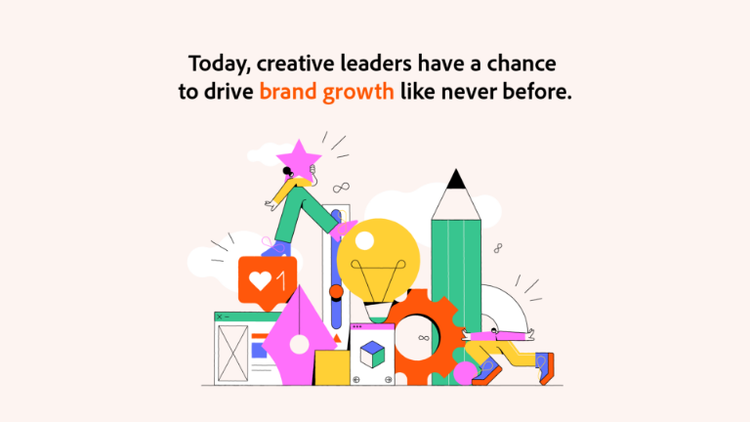Creativity that sells — a creative leader’s guide to driving business growth.
Strategy 1: Combine data and empathy.
For creative professionals trained to think in terms of emotion and personal connection, “data” can feel like just another four-letter word. In reality, data and emotion go hand in hand when it comes to crafting the tailored experience customers expect from brands.
Shawn Perkins is an independent creative director with more than 20 years of experience working with small and midsize brands. Throughout his career, he’s seen countless examples of creative teams using data to connect with audiences, but none like his experience designing TV spots for the Holocaust Memorial Museum in Washington, D.C.
“This was their first foray into mass TV fundraising, and so they had all kinds of questions about what was going to be the most effective type of story to tell, and how to tell it,” he says. It was especially important to determine how much tragedy a viewer could absorb before disengaging. To find out, Perkins and the museum partnered with Nielsen to test individuals’ responses to different videos — by observing how and when different parts of their brains would light up — and then used the findings to refine the videos. By the time the campaign went to market, he already knew how viewers would respond. It proved to be a huge success.
“A lot of people tend to use data to dehumanize people, to treat them like robots,” Perkins says. “Whereas I think it actually gives us an incredible opportunity to find human insights.”
While you won’t typically be able to measure your customers’ brainwaves in a neuroscience lab, you likely have access to loads of data about how customers are interacting with your brand’s digital content. The more you can weave that data into your team’s creative process, the more likely you are to design experiences that lead to outcomes like customer acquisition and revenue growth.
Strategy 2: Learn to speak your stakeholders’ language.
Understanding your customers is one thing. Understanding your internal stakeholders is another — but in many ways, the process is the same.
“You have to learn who the audience is and be able to speak their language,” Perkins says. This can be challenging for creative professionals working for highly specialized brands or clients, but the payoff is worth the effort, says Zack Rovella, creative director at Waltz Creative. His clients include physicians, accountants, engineers, and other technically-trained professionals. Speaking design to them, he says, is rarely productive. Instead, he’s learned to frame concepts in their terms — using language that describes their unique challenges, opportunities, and success metrics. “It's about giving them the confidence that we're making good decisions, and that we have a process to do that through design,” he says.
Ben Child, vice president of Brand at Quantum Metric, has been a creative leader at several small and midsize companies — most recently Workfront, which Adobe acquired in late 2020. In his experience, great creative work depends on strong relationships with stakeholders. Grab lunch with coworkers from other teams. Or, if you’re working remotely, make a special effort to converse over the phone or video chat rather than simply through emails and messaging apps. “First and foremost, you have to build trust,” Child says.
Gaining your stakeholders’ trust and confidence is about more than improving life at the office. The better you’re able to communicate with those responsible for setting the business goals, the better you’re able to design solutions that align with those goals. “There's an ‘Aha’ that happens once you understand them as people and you understand their business,” Perkins says. “Everything comes together really quickly after that.” Informed decisions replace guesswork, understanding ousts assumptions, and meandering meetings give way to quick, focused emails when creative professionals are able to situate their work within the broader picture.
As important as efficiency is for cutting costs and driving revenue growth, there’s an even better argument for staying in sync with your stakeholders. “If you can learn to speak their language, you can help yourself frame the problem better so that you can solve it better,” Perkins says. This is true whether the goal is reaching new customers or engaging better with the ones you already have. When creative professionals understand the relationship between their designs and long-term strategies, “it leads to more excitement behind the work, and it leads to better ideas.”

Strategy 3: Take part in more strategy conversations.
Getting on the same page as your business counterparts allows you to do more than deliver solutions that meet or exceed their goals. By connecting with stakeholders early and often, you are positioning yourself as a strategic partner who can help shape the customer experience.
“Too often creative professionals take their creative brief and go into a cave, then come back and say, ‘Voila!’” says Perkins. “Instead, they should be bringing stakeholders into the creative process and building consensus along the way.”
For John Meese, executive creative director at BambooHR, building buy-in starts before he and his team ever see a creative brief. “We’ve worked really hard to get creative professionals at more tables,” he says — particularly in other departments’ strategy sessions. “That way, we can spot red flags and pivot projects early on.”
Sometimes, taking greater ownership of the customer journey means looking further down the funnel. After COVID-19 put a sudden end to in-person meetings, Rovella found himself working directly with his clients’ sales teams to identify alternative methods for pitching their services to potential customers. “We had to give them the tools and the message to reach their audience in brand new ways overnight,” he says. To succeed, Rovella and his team used frequent feedback from the sales teams to constantly refine the messaging.
Strategy 4: Test, reflect, adjust.
Refining solutions based on real-time feedback isn’t just required in a crisis. It’s the basis of any successful strategy in today’s digital-first marketplace. A 2018 McKinsey study listed constant iteration based on end-user input as one of the very best ways for any design team to boost their brand’s bottom line.
One benefit of iteration is that it “de-risks” the creative development process. Adam Morgan, executive creative director at Adobe, has seen this de-risking firsthand. Go the traditional route of building and releasing an entire website or campaign all at once, and “you may find that you’ve spent a ton of time and money working on the wrong features,” he wrote in his book Sorry Spock, Emotions Drive Business. Once that happens, there’s not much you can do except run an autopsy and hope to learn from your mistakes. In contrast, stagger your assets and refine them as you go, and a miss is not a tragedy, but a data point.
The solutions that emerge from an iterative process are usually better — and it’s easy to see why. In this approach, “you try something, test it, analyze the results, discover the insights, then go back and try some more,” Morgan writes. “You’re constantly tweaking, prototyping, and learning as you go.”
Like getting on the same page with your stakeholders, this process has the two-fold business benefit of boosting efficiency and amplifying the impact of the final solution. Only this time, it’s better insight from customers empowering your team to innovate faster and more effectively.
Strategy 5: Use integrated and flexible creative tools.
An iterative approach requires flexible tools. New versions of files stack up quickly, as do reviewers’ comments. Analytics arrive from diverse sources. Without the right platforms and processes, making sense of it all can feel like trying to hold a tea party in a tornado.
For his part, Rovella can’t imagine trying to design, monitor, and update customer experiences without his cloud-based tools. “Cloud technology has changed our business immensely since it came on the scene,” he says. For example, when reviewing work internally, his team relies heavily on the cloud version of Adobe Acrobat, which has saved them having to pass a single PDF back and forth while crossing their fingers that the file they’re working on is the most recent version.
Rovella and his team are not alone. A recent Forrester study of creative professionals worldwide found that 75 percent of respondents believed they could be more productive if their tools were more integrated. Creativity solutions that foster seamless collaboration — within creative teams as well as between creative pros and their business stakeholders — can help you bring customer experiences to market faster and iterate based on data-driven customer insights. By embracing tools with features like robust asset libraries, creative teams are equipped for the kind of collaboration that drives business growth.
Set yourself up to thrive.
Today’s creative professionals need to do more than understand great design. To thrive in the digital-first world, creative teams must deliver great design that drives customer acquisition and revenue growth. It may sound daunting, but you’ve been building the required skills your whole career — it’s just a matter of applying them in new ways.
It takes empathy and intuition to turn data into insight. The same is true for connecting with business stakeholders. To design a successful customer journey, you have to imagine yourself in your customers’ shoes — something creative professionals do all day long. Adjusting to new processes and platforms can be tough. But creative professionals have a knack for problem-solving and experimentation. You and your team are already primed to succeed, and with a few small adjustments, you can deliver even more value to your customers and your business.

Adobe can help.
Adobe Creative Cloud for teams gives you the world’s best creative apps and services in a single, secure, integrated platform. With 20+ industry-leading apps, Creative Cloud Libraries for keeping assets in sync across apps and devices, and 1TB of storage per user, this complete creativity solution is designed to support your business at every stage of growth. Plus, you can count on simplified license management and total control over your software to help your team stay focused on creating great work.
